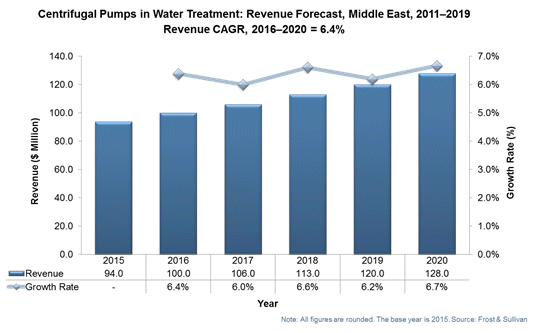Though oil and gas remains the biggest segment for centrifugal pumps in Middle East, water treatment is expected to have a fair share in the centrifugal pumps market over the long term. The Middle East region is amongst the most water scarce regions in the world. While the global per capita average water availability hovers around 7,000 cubic meter per person per year, the water availability in the ME region is around 1,200 cubic meter per person per year.
The region faces this issue due to two factors, namely:
- The region has nearly 6 percent of the global population with only 1.4 percent of the world’s known freshwater sources, leading to scarcity of freshwater.
- MENA region experiences a contrasting scenario in low rainfall and higher evaporation rates leading to lower groundwater recharge. In addition, climate change is likely to exacerbate the water shortage problem in the region.
Desalination and groundwater extraction are the two key sources of freshwater in Middle East. Increasing population in the region with depleting resources of freshwater is adding pressure on the region’s existing resources and desalination is the key to the region’s aim of achieving water sustainability. The market for centrifugal pumps for water treatment in the Middle East region is expected to grow at a CAGR of 6.4% from 2016 to 2020.

Desalination is the process of removing dissolved minerals, including salt, from seawater. Distillation and Reverse Osmosis (RO) are the two major techniques used in Middle East for desalination. As the demand for freshwater grows, the size of desalination plants can be expected to increase resulting in demand for pumps with higher pumping capacity. The various pumps used in the RO process are seawater intake pumps, filtered water pumps, high pressure pumps, booster pumps, and potable water pumps. The pump types include both centrifugal and end suction pumps, multistage pumps, and vertical mixed flow pumps among others. The RO process requires water to be pumped at higher pressures, hence multistage centrifugal pumps capable of generating such head and discharge levels are used. Seawater intake pumps generally handle capacities in excess of 25,000 m3 per hour, whereas booster pumps (used in the process) may handle capacities in excess of 1,000 m3 per hour.
The region is also well known for highest groundwater extraction rates in the world and has utilized more than 70 percent of known renewable sources of freshwater. Scarcity of freshwater sources has led to increase in groundwater treatment and usage in the region. Pumps are a key component in water extraction and cater to the growing demand for water in the region. They are used to lift water from dams and underground streams and move it from one place to another. Both centrifugal and end suction pumps can be used to extract water from dams and underground water treatment. However, the centrifugal pumps are preferred due to their efficiency and throughput for extraction of ground water. The key factors considered while evaluating the type of pumps are their physical dimension, lift capacity, water sample, flow rate required, and maintenance costs. Submersible pumps are widely used for water lifting from dams and underground sources of freshwater. The material of construction typically preferred is stainless steel because of its higher strength, ability to handle corrosive materials, and underground water composition.
Currently, Middle East’s policymaker’s face a tremendous challenge from the growing demand for freshwater and the sources that can cater to such a requirement. Desalination caters to more than 50 percent of the region’s needs for freshwater and the rest is catered by groundwater and dams. Given the demand for freshwater expected to increase over the long term, the demand for centrifugal pumps is expected to follow the trend in future.



